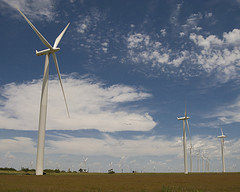Energy Use in a Steady State Economy
In a steady state economy, conservation of energy is held in high regard. People look for ways to accomplish their goals while minimizing energy inputs. Societies phase out fossil fuels, and instead favor energy sources that use solar income, such as photovoltaic cells, wind turbines, biofuels and hydroelectric generators. Businesses and households retrofit existing structures to be more energy-efficient, and eliminate machines that consume wasteful amounts of energy, especially items consumed for status.
 | More of this…A mixture of conservation and Image credit: Ninjawil |
Energy Use in an Economy Shooting for Perpetual Growth
More production and consumption means more energy usage. Even when societies can produce economic output more efficiently (less energy input per unit of economic output), they use a bigger overall supply of energy resources to accommodate growth. Households, businesses, and governments use unnecessary amounts of energy, grab as many energy resources as possible to fuel economic growth, and externalize the costs of using these resources to the greatest extent possible. Side effects from increasing energy inputs, such as pollution and climate disruption from burning fossil fuels and ecosystem disturbance from resource extraction, continue to get worse. Nations also compete vigorously and sometimes violently for valuable energy resources. The result is degraded environmental and social conditions.
 | Less of that…Burning coal and loading the atmosphere Image credit: Davipt |
Exemplary Energy Use
Samso is an island powered by renewable energy. The 4,000+ residents power their homes, farms and businesses with a mixture of solar power, wind-generated electricity, and biofuels from local crops. A central heating system that runs on locally grown straw delivers hot water to homes, and provides much higher efficiency than individual furnaces. Although some vehicles use non-renewable fuel, residents maintain carbon neutrality. They offset carbon emissions by selling wind-generated electricity to the mainland. Amazingly, the energy generation facilities and upgrades were mostly financed by residents. Rather than investing their money in a stock market casino or far-flung multinational corporations, they have wisely invested in their economic and environmental future by establishing a renewable energy infrastructure.